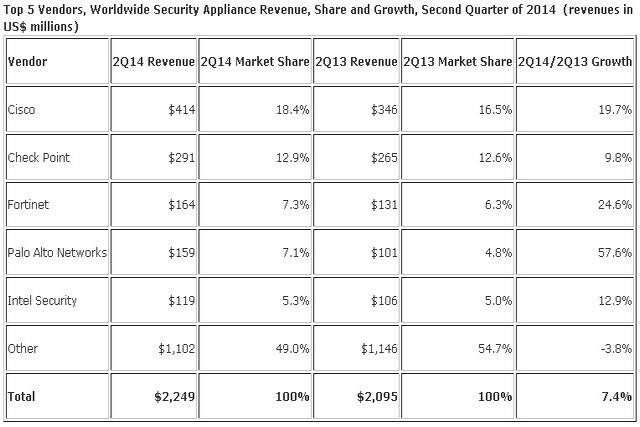Security appliance market revenue grew 7.3 percent year over year to reach at $2.2 billion, during second quarter of 2014. This was the 19th consecutive quarter of positive growth, dating back to the fourth quarter of 2009, said the market research firm IDC. Second quarter shipments also grew, totaling 500,178 units, up 4.9 percent over the 476,903 units shipped in 2Q13.
Geographically, Latin America saw the highest growth in the quarter at 24.5 percent. Asia/Pacific also saw strong appliance sales, with revenue increasing 11.3 percent compared to 2Q13. North America grew 6.0 percent in the quarter while accounting for 39.4 percent of market revenues. Western Europe saw its highest growth since the first quarter of 2011, with revenue increasing 6.8 percent year over year.
Cisco continues to lead the overall security appliance market with 18.4 percent share of factory revenue in the second quarter with year-over-year growth of 19.7 percent. Check Point again held the number two spot for the quarter as revenue increased 9.8 percent, followed by Fortinet which retained the third largest security appliance vendor as its market share increased to 7.3 percent on growth of 24.6 percent over 2Q13. Palo Alto Networks rose to the number four spot on growth of 57.6 percent. Intel Security rounded out the top 5, growing 12.9 percent year over year and accounting for 5.3 percent of the market.
At the functional market level, the Unified Threat Management (UTM) segment saw the largest year-over-year revenue increase at 21.5 percent and accounted for 43.6 percent of security appliance revenue in 2Q14.
The Firewall market remained constant year over year, and represented 19.2 percent of security appliance revenue in the quarter. The Content Security and Intrusion Detection and Prevention (IDP) segments made up 17.2 percent and 16 percent of the market, respectively, with Content Security declining 0.9 percent and IDP declining 1.2 percent year over year.
“With countless Web site hacks and data thefts, network encryption and information protection are more important than ever,” said Ebenezer Obeng-Nyarkoh, senior research analyst, Worldwide Trackers Group “Trying to track new security vulnerabilities can be overwhelming because so many Web-based applications use services that are not up to date on all of their network and services.”
)